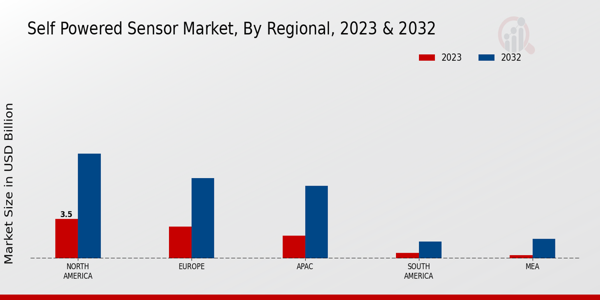Market Growth Projections
The Global Self-Powered Sensor Market Industry is projected to experience substantial growth over the next decade. With a market value of 11.4 USD Billion in 2024, it is anticipated to reach 39.2 USD Billion by 2035. This growth trajectory suggests a compound annual growth rate of 11.89% from 2025 to 2035, indicating a robust demand for self-powered sensor technologies across various sectors. The increasing emphasis on energy efficiency, IoT integration, and sustainable practices is likely to drive this market expansion, positioning self-powered sensors as a critical component of future technological advancements.
Advancements in IoT Integration
The integration of self-powered sensors within the Internet of Things (IoT) ecosystem is a pivotal driver for the Global Self-Powered Sensor Market Industry. As IoT devices proliferate, the need for sensors that can operate autonomously without external power sources becomes critical. These sensors can collect and transmit data seamlessly, enhancing operational efficiency in sectors such as agriculture, healthcare, and smart cities. The anticipated growth in IoT applications is likely to propel the market forward, with a projected compound annual growth rate of 11.89% from 2025 to 2035, indicating a robust future for self-powered sensor technologies.
Increased Focus on Smart Cities
The Global Self-Powered Sensor Market Industry is significantly influenced by the global push towards developing smart cities. Governments and urban planners are increasingly investing in technologies that enhance urban living through improved infrastructure and resource management. Self-powered sensors play a crucial role in this transformation by enabling real-time monitoring of traffic, air quality, and energy consumption. For example, smart streetlights equipped with these sensors can adjust brightness based on pedestrian presence, thereby conserving energy. This trend is expected to contribute to the market's growth, with projections suggesting a market value of 39.2 USD Billion by 2035.
Growing Demand for Energy Efficiency
The Global Self-Powered Sensor Market Industry is experiencing a surge in demand for energy-efficient solutions across various sectors. As organizations strive to reduce operational costs and minimize their carbon footprint, self-powered sensors, which harness energy from their environment, become increasingly attractive. For instance, in smart buildings, these sensors can optimize energy usage by monitoring occupancy and adjusting lighting accordingly. This trend is expected to drive the market's growth, with projections indicating a market value of 11.4 USD Billion in 2024, reflecting a growing awareness of sustainability and energy conservation.
Rising Adoption in Healthcare Applications
The healthcare sector is witnessing a notable increase in the adoption of self-powered sensors, which is a key driver for the Global Self-Powered Sensor Market Industry. These sensors facilitate continuous patient monitoring without the need for frequent battery replacements, thus enhancing patient care and operational efficiency in healthcare facilities. For instance, wearable health devices that utilize self-powered sensors can track vital signs and transmit data to healthcare providers in real-time. This trend is likely to gain momentum as the healthcare industry increasingly prioritizes remote monitoring and telehealth solutions, further propelling market growth.
Regulatory Support for Sustainable Technologies
Regulatory frameworks promoting sustainable technologies are significantly impacting the Global Self-Powered Sensor Market Industry. Governments worldwide are implementing policies that encourage the adoption of energy-efficient solutions, including self-powered sensors. Such regulations not only aim to reduce greenhouse gas emissions but also to foster innovation in sensor technologies. For example, incentives for renewable energy use can enhance the viability of self-powered sensors in various applications. This supportive regulatory environment is expected to facilitate market expansion, as companies increasingly align their product offerings with sustainability goals.






















Leave a Comment